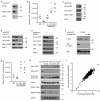The cytotoxic T cell proteome and its shaping by the kinase mTOR
- PMID: 26551880
- PMCID: PMC4685757
- DOI: 10.1038/ni.3314
The cytotoxic T cell proteome and its shaping by the kinase mTOR
Abstract
We used high-resolution mass spectrometry to map the cytotoxic T lymphocyte (CTL) proteome and the effect of the metabolic checkpoint kinase mTORC1 on CTLs. The CTL proteome was dominated by metabolic regulators and granzymes, and mTORC1 selectively repressed and promoted expression of a subset of CTL proteins (~10%). These included key CTL effector molecules, signaling proteins and a subset of metabolic enzymes. Proteomic data highlighted the potential for negative control of the production of phosphatidylinositol (3,4,5)-trisphosphate (PtdIns(3,4,5)P3) by mTORC1 in CTLs. mTORC1 repressed PtdIns(3,4,5)P3 production and determined the requirement for mTORC2 in activation of the kinase Akt. Our unbiased proteomic analysis thus provides comprehensive understanding of CTL identity and the control of CTL function by mTORC1.
Figures








Comment in
-
The cell identity of cytotoxic T lymphocytes.Nat Immunol. 2016 Jan;17(1):45-6. doi: 10.1038/ni.3350. Nat Immunol. 2016. PMID: 26681463 No abstract available.
References
-
- Heng TSP, Painter MW. The Immunological Genome Project: networks of gene expression in immune cells. Nat. Immunol. 2008;9:1091–1094. - PubMed
-
- Schwanhäusser B, et al. Global quantification of mammalian gene expression control. Nature. 2011;473:337–342. - PubMed
-
- Larance M, Lamond AI. Multidimensional proteomics for cell biology. Nat. Rev. Mol. Cell Bio. 2015;16:269–280. - PubMed
Publication types
MeSH terms
Substances
Associated data
- Actions
Grants and funding
- 105024/Z/14/Z/WT_/Wellcome Trust/United Kingdom
- 073980/WT_/Wellcome Trust/United Kingdom
- 097418/WT_/Wellcome Trust/United Kingdom
- 105024/WT_/Wellcome Trust/United Kingdom
- 065975/Z/01/A/WT_/Wellcome Trust/United Kingdom
- BBS/E/B/000C0415/BB_/Biotechnology and Biological Sciences Research Council/United Kingdom
- 093713/Z/10/A/WT_/Wellcome Trust/United Kingdom
- 073980/Z/03/Z/WT_/Wellcome Trust/United Kingdom
- 093713/WT_/Wellcome Trust/United Kingdom
- 097418/Z/11/Z/WT_/Wellcome Trust/United Kingdom
- BBS/E/B/000C0413/BB_/Biotechnology and Biological Sciences Research Council/United Kingdom
LinkOut - more resources
Full Text Sources
Other Literature Sources
Molecular Biology Databases
Miscellaneous

